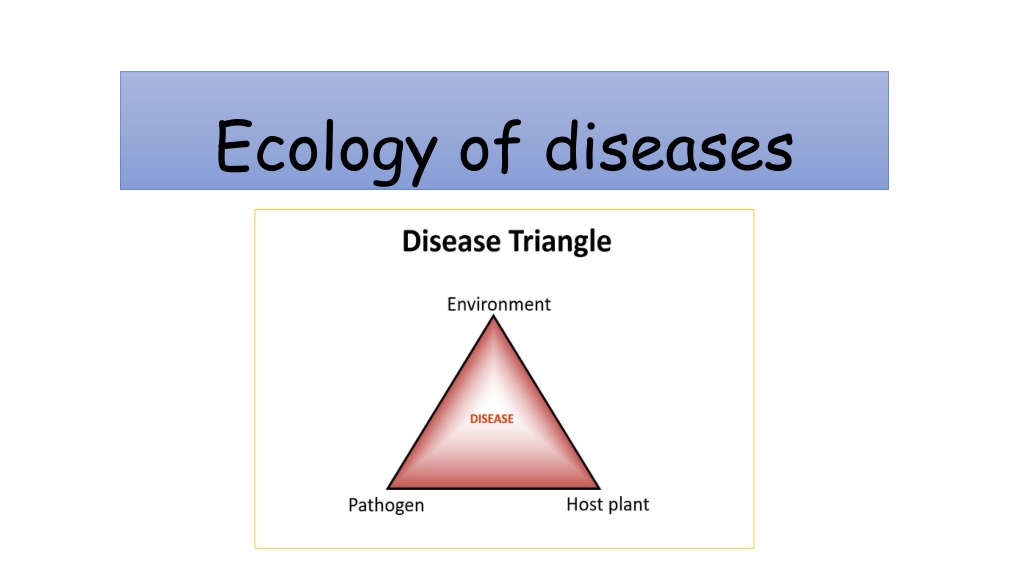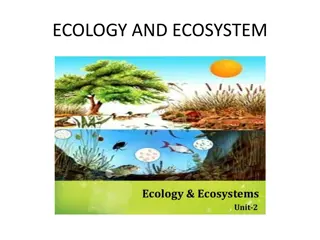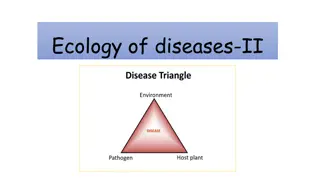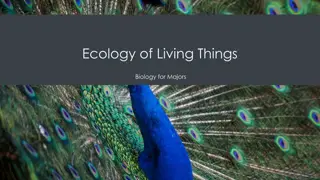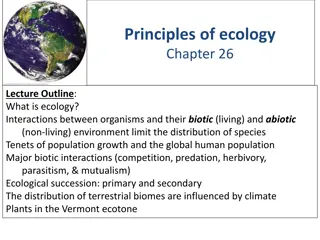Understanding Ecology of Diseases: An Overview
Ecology plays a crucial role in the study of disease patterns and transmission. By understanding the ecological factors influencing disease spread, researchers can predict outbreaks and develop effective control strategies. Concepts like animal populations, food availability, and competition shape the occurrence of diseases, emphasizing the importance of ecological knowledge in epidemiological investigations.
Download Presentation

Please find below an Image/Link to download the presentation.
The content on the website is provided AS IS for your information and personal use only. It may not be sold, licensed, or shared on other websites without obtaining consent from the author. Download presentation by click this link. If you encounter any issues during the download, it is possible that the publisher has removed the file from their server.
E N D
Presentation Transcript
What is ecology?? Ecology (Greek: oikos= house; logo- = discoursing) The study of animals and plants in relation to their habits and habitation (habitat) is ecology The study of a disease's ecology (also termed its natural history) is frequently a part of epidemiological investigations
Objectives of ecology 1. An increase in the understanding of the pathogenesis, maintenance and, for infectious agents, transmission of disease 2. The use of knowledge of a disease's ecology to predict when and where a disease may occur, to enable the development of suitable control techniques
Basic ecological concepts Factors: Determine the occurrence of disease Size of animal populations Availability of food, Availability of mates & the species' Breeding potential Distribution of animal populations Distribution of suitable food Distribution of suitable food Distribution of suitable food The balance of nature Control of population size by competition Dispersal Predation Vegetation zone Tundra Savannah Desert Home range Biomes Territoriality Social dominance
Factors effecting the disease spread 1. The distribution of host 2. Home range: if home range increase: increase disease 3. Other behavioral activities of host: ex. Rabies in foxes in Europe Dump rabies: solitary existence Furious rabies: approach other animals
The Niche This is the functional position of an animal s The match of a species to a specific environmental condition How an organism or population responds to: Distribution of resources Competitors (for when predators, parasites and pathogens are scarce) example, by growing when resources are abundant (How it in turn alters those same factors (for example, limiting access to resources by other organisms, acting as a food source for predators and a consumer of prey)
The Niche Competition: Intra species competition Inter species competition Coexistence of two strongly competing species is impossible This led to the principle of competitive exclusion: that competition will exclude all but one Species from a particular position defined by an animal's feeding habits, physiology, mechanical abilities and behavior Competitive exclusion has been used as a means of disease control (Ex. The snail Biompholaria glabrata (I/H of Schistosomiasis) Marisa cornuarietis (more competitive snail)
The Niche Other example: 1. Louse infestation: Host specific so avoid competition 2. Intracellular parasitism: Occupy niche in cell All viruses Some bacteria (Mycobacterium, Rickettsiae, Brucella spp.) Some protozoa (Babesia spp.)
Epidemiological interference One type of respiratory adenovirus prevents infection with other types, even though the latter are common in surrounding community 1. Can effect the time of occurrence of disease: Ex. altering age specific incidence rate 2. Alters the rate of natural immunization: Ex. Interference by other enterovirus delays natural poliovirus immunization in man
The relationships between the different types of plant and animals Food chain: Simplistic view of the relationship between an animal and its food
The relationships between the different types of plant and animals Food webs and size of animals:
